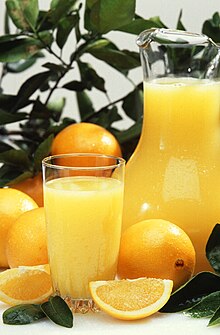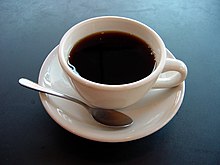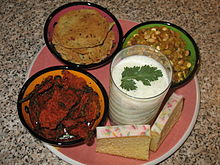Drink
This article needs additional citations for verification. (February 2011) |
A drink, or beverage, is a kind of liquid which is specifically prepared for human consumption. There are many groups for drinks. It can be divided into various groups such as plain water, alcohol, non alcoholic drinks, soft drinks (carbonated drinks), fruit or vegetable juices and hot drinks. In addition to fulfilling a basic need, drinks form part of the culture of human society.
Alcohol

An alcoholic beverage is a drink that contains ethanol, commonly known as alcohol (although in chemistry the definition of "alcohol" includes many other compounds). Beer has been a part of human culture for 8,000 years.[1] In many countries, drinking alcoholic beverages in a local bar or pub is a cultural tradition.[2] Asian countries produce several varieties of alcoholic beverages (e.g. rice wine, Tongba a millet brew).
Non-alcoholic drinks
A non-alcoholic drink is one that contains little or no alcohol. This category includes low-alcohol beer, non-alcoholic wine, and apple cider if they contain more than 0.5% alcohol by volume. it takes 30 units to get drunk
Soft drinks
The term "soft drink" specifies the absence of alcohol in contrast to "hard drink" and "drink". The term "drink" is neutral but often denotes alcoholic content. Beverages such as soda pop, sparkling water, iced tea, lemonade, root beer, and fruit punch are the most common soft drinks. Milk, hot chocolate, tea, coffee, milkshakes, and tap water are not considered to be soft drinks. Some carbonated soft drinks are available in versions that are sweetened with a sugar substitute.
Fruit juice

Fruit juice is a natural product that contains few or no additives. Citrus products such as orange juice and tangerine juice are familiar breakfast drinks. Grapefruit juice, pineapple, apple, grape, lime, and lemon juice are also common. Coconut water is a highly nutritious and refreshing juice. Many kinds of berries are crushed and their juices mixed with water and sometimes sweetened. Raspberry, blackberry and currants are popular juices drinks but the percentage of water also determines their nutritive value. Juices were probably the earliest drinks besides water.[citation needed] Grape juice allowed to ferment produces wine. Orange juice and coconut water remain by far the most highly consumed juices[citation needed].
Fruits are highly perishable so the ability to extract juices and store them was of significant value. Some fruits are highly acidic and mixing them with water and sugars or honey was often necessary to make them palatable. Early storage of fruit juices was labor intensive, requiring the crushing of the fruits and the mixing of the resulting pure juices with sugars before bottling.
Vegetable juice
Vegetable juice are usually served warm or cold. Different types of vegetables can be used to make vegetable juice such as carrots, tomatoes, cucumbers, celery and many more. Some vegetable juices are mixed with some fruit juice to taste better. Many popular vegetable juices, particularly ones with high tomato content, are high in sodium, and therefore consumption of them for health must be carefully considered. Some vegetable juices provide the same health benefits as whole vegetables in terms of reducing risks of cardiovascular disease and cancer.
Hot drinks


A hot drink is any beverage which is normally served heated, by the addition of a heated liquid, such as water or milk, or by directly heating the drink itself. Examples:
- Coffee-based beverages
- Hot chocolate
- Hot cider
- Mulled cider
- Malted milk
- Maté
- Mulled wine
- Teas
- Flavored teas (chai, Earl Grey, etc.)
- Green tea
- Pearl milk tea
- Tisanes
- Roasted grain beverages
Miscellaneous

Some substances may be defined as either food or drink, and accordingly may be eaten with a spoon or drunk, depending upon their thickness and solutes.
Measurement
| Unit | Australia | UK | US | ||
|---|---|---|---|---|---|
| ml | imp fl oz | ml | US fl oz | ml | |
| dash | 1/48 | 0.592 | 1/48 | 0.616 | |
| teaspoon | 5 | 1/8 | 3.55 | 1/6 | 4.93 |
| tablespoon | 20 | 1/2 | 14.2 | 1/2 | 14.8 |
| fluid ounce, nip or pony | 30 | 1 | 28.413 | 1 | 29.574 |
| shot, bar glass or jigger | 30 | 3/2 | 42.6 | 3/2 | 44.4 |
| can of drink | 375 | 11.6 | 330 | 12 | 355 |
| pint | 570 | 20 | 568 | 16 | 473 |
| bottle of spirits | 700 | 24.6 | 700 | 25.3 | 750 |
| bottle of wine | 750 | 26.4 | 750 | 25.3 | 750 |
See also
References
- ^ Arnold, John P (2005). Origin and History of Beer and Brewing: From Prehistoric Times to the Beginning of Brewing Science and Technology (Reprint ed.). BeerBooks.com.
- ^ Hamill, Pete (1994). A Drinking Life: A Memoir. New York: Little, Brown and Company. ISBN 978-0-316-34102-8.
